
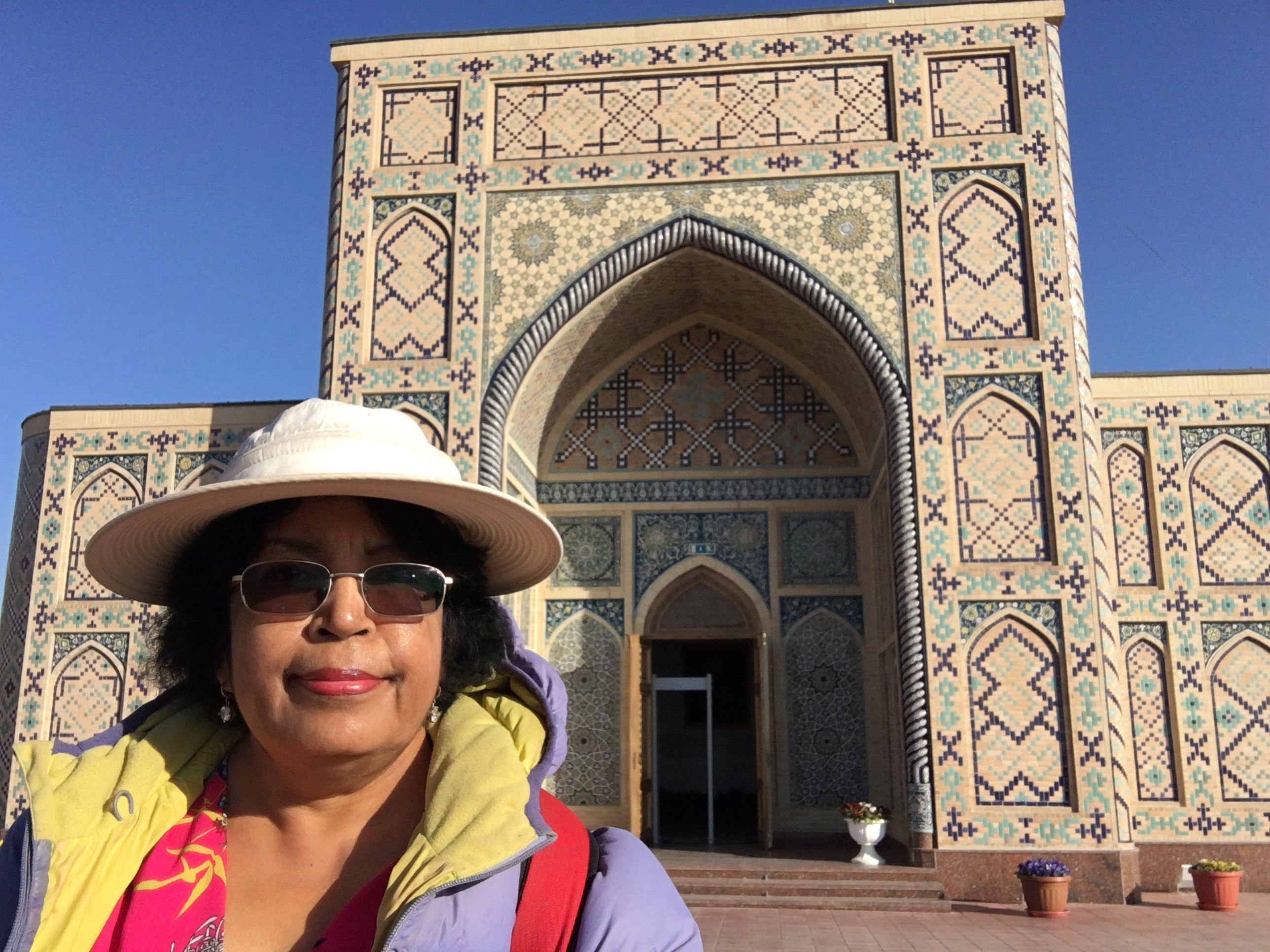
During my current world tour I included travelling in Uzbekistan on a friend’s advise. I was absolutely awestruck when I went there. I never could expect what was waiting for me there, a country not much heard about and not in many people’s “Things to see” list but so much to offer.
I took a package tour with the Advantour group and travelled in Uzbekistan for twelve days. During this period I had the opportunity to see several important places of Uzbekistan. In every place I had a tour guide and the program was jam packed. I have been taken to many places and was shown many things which I have thoroughly enjoyed. I cannot write about everything in this short space. I’ll try to write about a few important places. However, I must admit, it is a difficult job to choose from all the places that I have seen and enjoyed so much.
Uzbekistan is a landlocked Central Asian state, bordered by five land locked countries, Kazakhstan to the North, Kyrgyzstan to the northeast, Tajikistan to the Southeast, Afghanistan to the South and Turkmenistan to the Southwest.
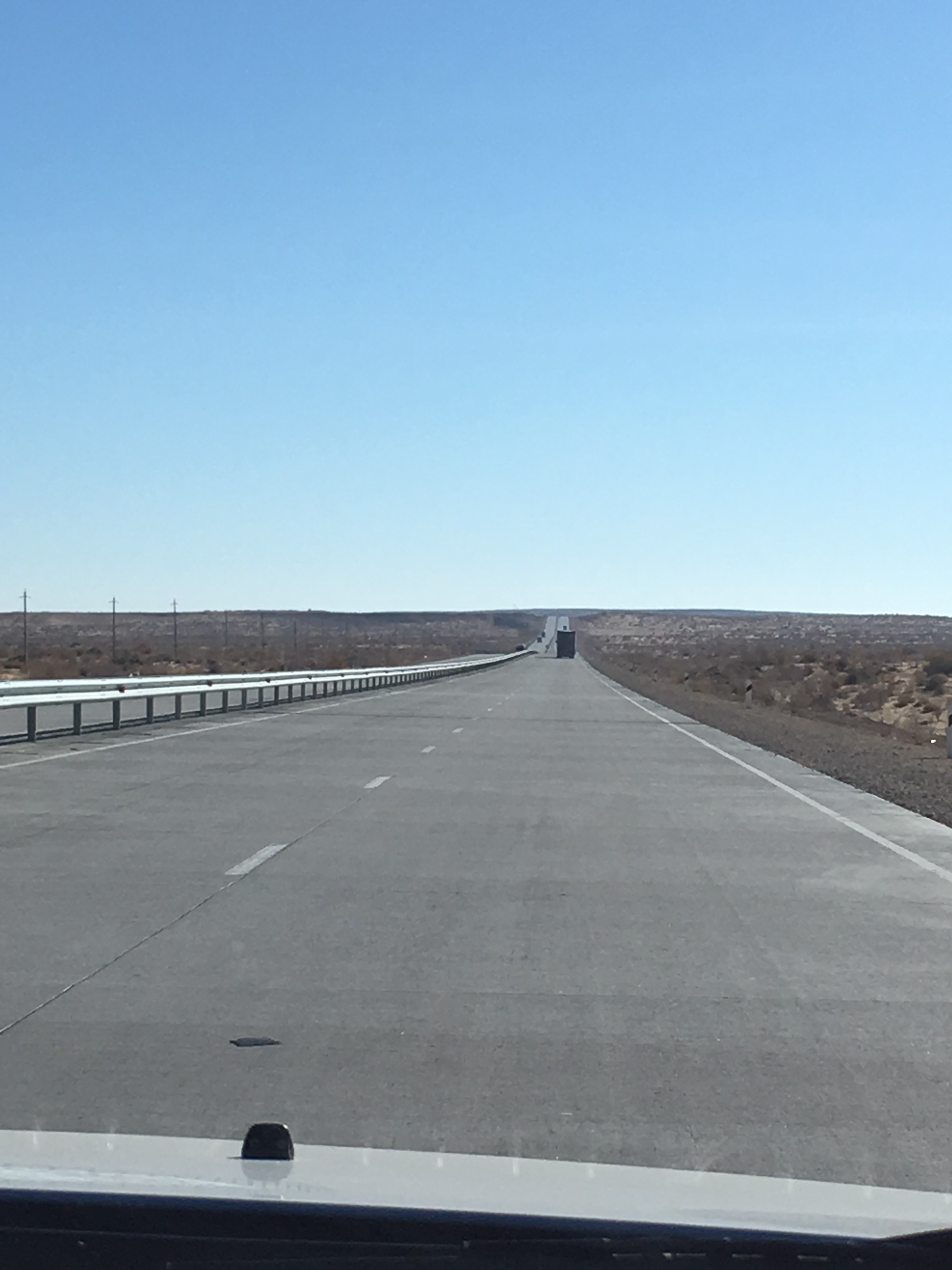
Many centuries ago, the Great Silk road contributed to the development of Central Asia connecting Europe with Asia. Uzbekistan played an important role in the Silk Road, especially the places like Khiva, Bukhara, Samarkand and Tashkent. These cities were the gems of the Silk Road.
In the 19th century, the Russian Empire spread into Central Asia and Russian troops invaded Uzbekistan. In 1924 the Uzbek Soviet Socialist was created. Uzbekistan got its independence from USSR on 31st August, 1991.
Uzbekistan is a major producer and exporter of cotton. The country also operates the largest open-pit gold mine in the world. With ample supply of natural gas, Uzbekistan has become the largest electricity producer in Central Asia. I did some research before going there but what I saw was beyond my expectation.
I flew to Tashkent where I was received at the Airport by a tour representative and was taken to my hotel. The next day was spent with one of my tour representatives, Kate, sorting out a few official matters. After we finished, Kate told me that her friends were having coffee at a Cafe close to my hotel and asked me if I would like to join them. I happily agreed. I had a very good time with the ladies. They all spoke very good English and we had a wonderful time learning the history and culture of Uzbekistan and discussing many cultural aspects. At the end, one of them walked with me to my hotel as she lived nearby. For the rest of the day I spent relaxing in my hotel.
The next morning, I flew to Nukus. My tour guide and Chauffer were waiting for me at the Airport. I was taken to my hotel and after leaving my luggage there I was driven to Aral Sea which was about a three hour drive. The Aral sea is one of the major saline lakes in the world. It is an example of a Natural disaster. Decades-old water diversions for irrigation and droughts have caused the lake to shrink making its flora and fauna disappear slowly. Old ships have been sitting on the sand for years. To me it was a sad scene.
Next day, I was driven to Khiva. My hotel in Khiva was just outside the Ichan Qala fortress. This perfectly preserved medieval walled town has dozens of mosques, Madrassas and mausolea. My tour guide came in the morning and we walked into the fortress. I would write about a few interesting things I have seen inside the fortress.
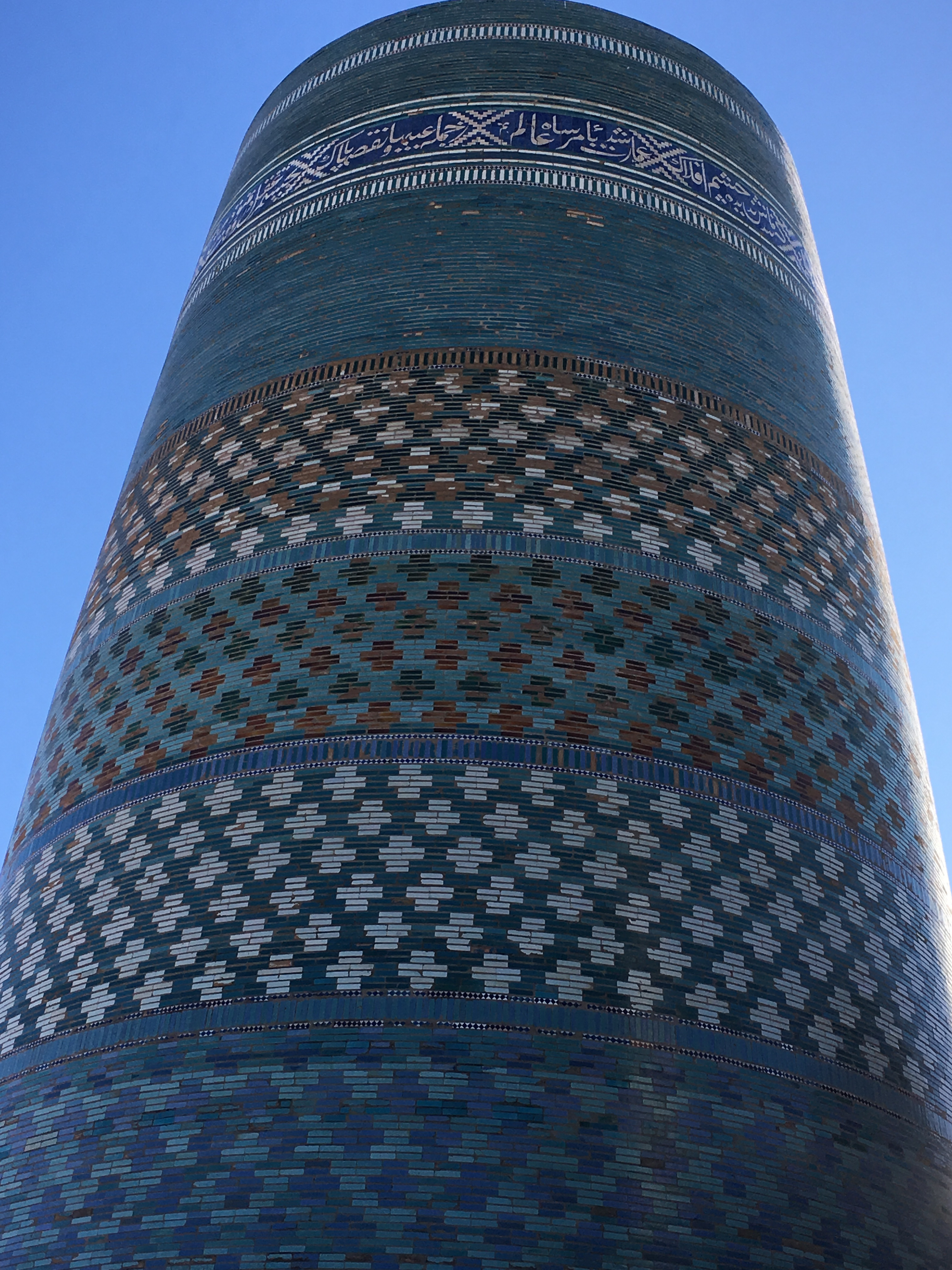
I was impressed to see Kalta-Minar Minaret. Mohammed Amin Khan, the then ruler of Khiva, wanted to build a minaret so high that he could see all the way to Bukhara. The work begun in 1851, however, the work was abandoned in 1855 when Amin Khan dropped dead. The minaret has striking dimensions: the foundation goes to a depth of 15 meters, the diameter at the base is 14.5 m and the height is 29 m which is one third of its design. The beautiful, half finished, turquoise-tiled minaret is still standing inside the fortress.

The statue of Al Khorezmi (780-850 AD) was another important thing that I saw. Al Khorezmi was the chief mathematician in the once-great Baghdad academy of sciences, also known as House of Wisdom. He made major contributions to the fields of algebra, trigonometry, astronomy, geometry and cartography. The word Algebra
came from Al Gabr (calculation) and the word algorith came from his name Al-Khorezmi. He introduced the merit of Hindu numerals 1-9 and 0 to the Islamic world and later it was accepted in Europe.
The Next day, I was driven to Bukhara which was about 450km from Khiva. The drive was through the desert. 260 km section of the road was very good but the rest was bumpy. It was very beautiful driving through the desert. As far as one could see, it was vast, open land. Occasionally we went past small towns. At some stages I saw camels roaming around, sometimes I could see a herd of cattle. It was mind boggling to see the vastness of the country. I have seen Sahara desert in Egypt and Lahbab desert in Dubai, but this was so different. I always love to see a country travelling by road. It was also a great feeling to think that the road was once part of the Silk Road. We stopped for a lookout of Amu Darya River. It was beautiful. I told my driver, Farid, that Darya in our language meant River. Farid said it has the same meaning in their language too. It must have come from Arabic language. We reached Bukhara at 4 p.m.
I had a guided walking tour around the city of Bukhara the next morning. It was a beautiful, sunny morning. The day started as a cold morning but I was fine with my comfy jacket. It was absolutely mind boggling to see the beauty of the place and listen to the history. It was a six hour walking tour which involved going up the steps and ramps and so on. We stopped for coffee. The name of my guide was Masuma. We stopped at a few places, Ismail Samani Mausoleum, Po-I Kalan complex, Kalyan minaret, Kalan mosque, Mir-I Arab Madrasah, Lab - I Hauz,Chor Minar, Bukhara Fortress and more.

Our first stop was at Ismail Samani Mausoleum. All the art works on it were done using bricks by laying them in various ways to make beautiful patterns. It was impressive!
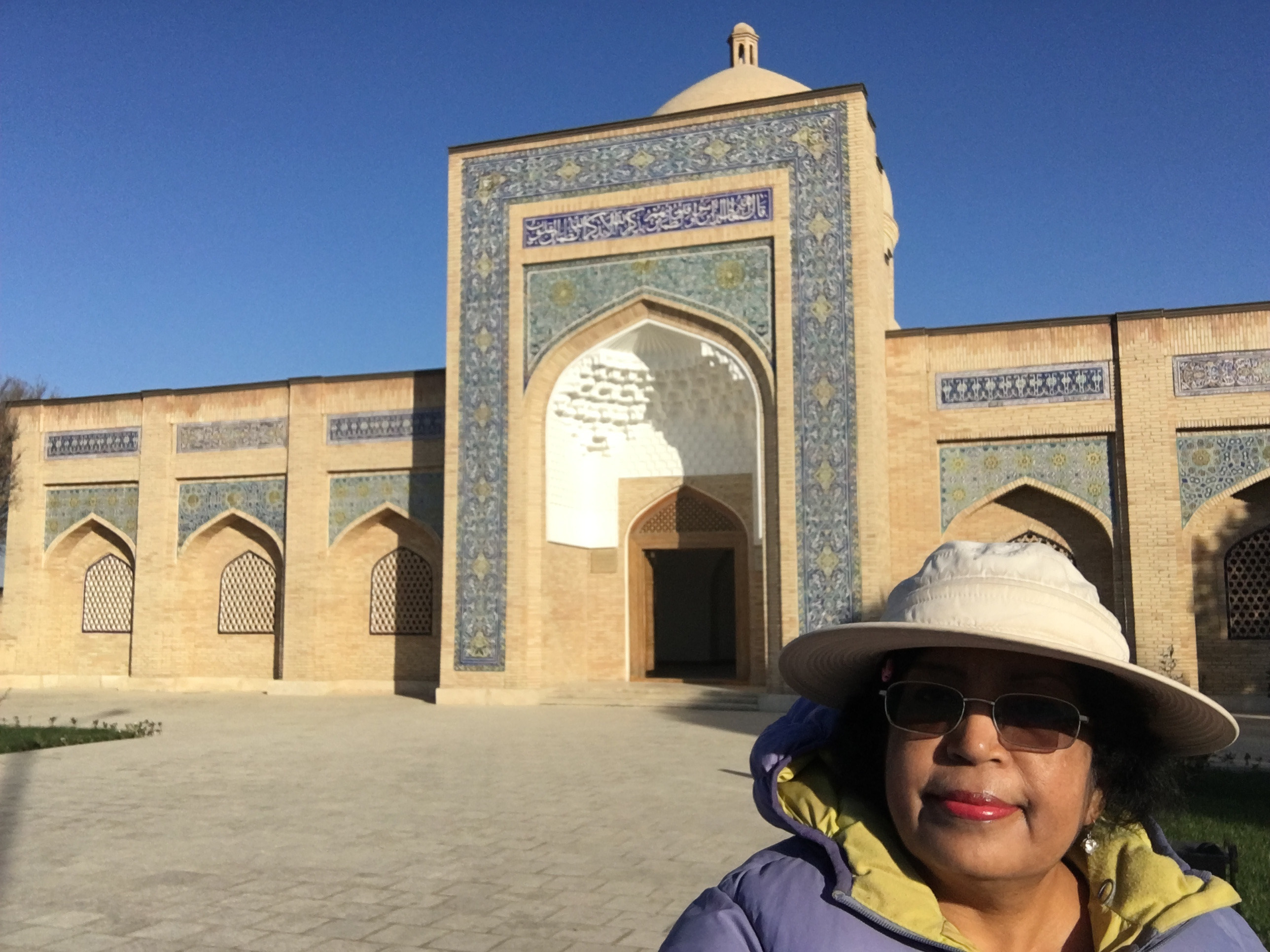
The most important place in Bukhara to me was the memorial complex of Khoja Bakhouddin Naqshbandi, 12 km from Bukhara city. Bakhouddin was the great theologian of the 15th Century and the founder of the Sufi Order. Khoja Bakhouddin was the spiritual leader of Amir Temur. His philosophy was based on the principle: “The heart to God, hands at work”. His mausoleum is considered as the Asian Mecca. Standing in the complex I felt great and peaceful. It was time for a quiet prayer.
I had a wonderful day travelling to Samarkand from Bukhara. It was a beautiful sunny and cool day. We started at 9 a.m. , stopped for coffee at 11 a.m. and kept driving.
On our way we stopped at Shakhrisabz for lunch and then went to Dor-us-Siodat Memorial complex. My tour guide, Magdel, was waiting for me there. She showed me around. It was a huge complex, built around ancient ruins. The entrance of the Ak-Sarai Palace was so beautiful! Built in 14th century the palace was called the White Palace. The work of the building started from 1380.
The original height of the gate tower was 65m. At the moment it is about 40m.
The garden was huge and beautiful. My tour guide also showed me a 700 year old tree. I had seen one in Bukhara as well.
My next stop was Samakhand.
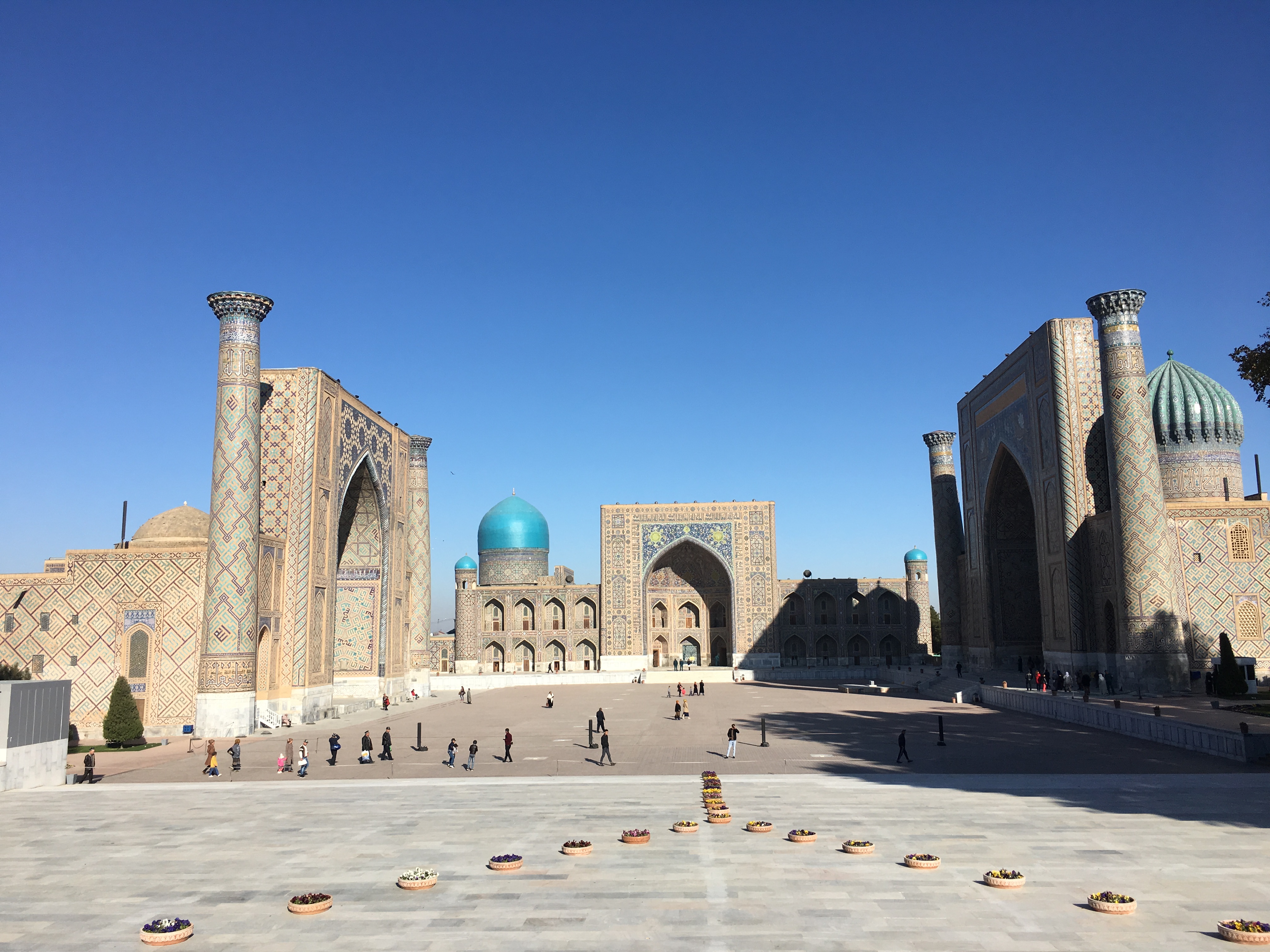
At the heart of Samakhand is the Registan Square. The word Registan means the Sandy Place or Desert in Persian. It comprises of beautiful and very distinctive Islamic architecture. It is framed by three important Madrasahs. The Ulugh Beg madrasah was the oldest (1417-1420). The other two were Sher-Dor Madrasah (1619-1636) and Tilya-Kori (1646-1660) . It was a huge complex with a beautiful surrounding. The place was an educational hub hundreds of years ago when students came from far away to learn
about Mathematics, Astronomy, Theology and many other subjects. My tour guide was showing me around and I found the place overwhelming.
From Registan Square I was taken to Ulugh Beg Observatory. Ulugh Begh Observatory was built in the 1420s by the Timurid ruler Ulugh Beg, grandson of emperor Timur. His father, Shah Rokh, captured the city of Samarkand and gave it to Ulugh Beg. Ulug Beg made Samarkand the center of Islamic culture.
Ulugh Beg also built a Madrasah in Bukhara. Ulug Beg’s main interest was in Science and intellectual matters. During his period these cities were the center for learning in Central Asia.
Ulugh Beg’s greatest interest was in Astronomy and he built an observatory in Samarkand. He found a number of errors in the computations of the second century Alexandrian astronomer Ptolemy. Ulugh Beg was quite renowned in the Western world for his contribution in Astronomy. His work was recognized by many Western Astronomers of his time and his books were translated into many other languages. His observatory was built on top of a hill. There was a museum next to the observatory which had excellent collections.
From Ulugh Beg Observatory, I was driven to Meros Paper mill. The mill was in a village called Koni Ghil. Here I had the opportunity to explore the traditional way of making Samarkhand paper from the bark of Mulberry trees. It was very interesting. The whole paper making process was manual and visitors can watch the process. The place is very picturesque, with shady trees near Siab river. At the entrance was a small tea house where we were served delicious tea. Loved it! The paper made was very strong and in the show room they had papers with beautiful embroidery on them. Dresses were made out of those papers.
From Samarkand I went to Tashkent via train. It was a beautiful train and the trip was very comfortable. After I arrived at the Tashkent station, I was picked up by our driver and was taken to my hotel.
Next day, I was picked up from my hotel by my tour guide to tour around Tashkent.
My first place of visit was Khast-Imom Complex where the world famous Quran of Caliph Uthman has been preserved. Photography was not allowed inside. I was extremely fascinated to see the Old Quran kept in the museum which was not in Arabic. The Quran was written in Syriac or Syrio Aramic which was the main written and spoken language at that time as Arabic was in it’s infancy. I also visited the Madrasah of Barak-Khan, Tilla Sheikh Mosque, Mausoleum of Saint Abu Bakr Kaffal Shashi and the Islamic Institute of Imam al-Bukhari.
From Khast Imom Square I was taken to Amir Temur Square. I also had the opportunity to see the Independence Square and Applied Arts Museum.
Everywhere I went I was impressed not only by the beauty of the historic place but also the wonderful planning. Spacious roads and gardens surrounded the complexes so that they don’t get crowded. It was really beautiful. Their planning of the historic sights for visitors was the best I have seen anywhere in the world.
Next morning, I flew out of Tashkent with many happy memories. I am so glad that I visited this very fascinating country.
Atia Nasreen, an educator and author, lives in Australia. Music and travel are her passion. She travelled around the world covering six continents and shows no sign of slowing down.